Files in this item
Extracting and classifying salient fields of view from microscopy slides of tuberculosis bacteria
Item metadata
| dc.contributor.author | Zachariou, Marios | |
| dc.contributor.author | Arandelovic, Oggie | |
| dc.contributor.author | Dombay, Evelin | |
| dc.contributor.author | Sabiiti, Wilber | |
| dc.contributor.author | Mtafya, Bariki Anyamkisye | |
| dc.contributor.author | Sloan, Derek James | |
| dc.contributor.editor | El Yacoubi, Mounîm | |
| dc.contributor.editor | Granger, Eric | |
| dc.contributor.editor | Yuen, Pong Chi | |
| dc.contributor.editor | Pal, Umapada | |
| dc.contributor.editor | Vincent, Nicole | |
| dc.date.accessioned | 2023-06-01T23:38:55Z | |
| dc.date.available | 2023-06-01T23:38:55Z | |
| dc.date.issued | 2022-06-02 | |
| dc.identifier | 278540430 | |
| dc.identifier | 6c36d198-8048-4397-b87d-03f52301ee16 | |
| dc.identifier | 85131951130 | |
| dc.identifier.citation | Zachariou , M , Arandelovic , O , Dombay , E , Sabiiti , W , Mtafya , B A & Sloan , D J 2022 , Extracting and classifying salient fields of view from microscopy slides of tuberculosis bacteria . in M El Yacoubi , E Granger , P C Yuen , U Pal & N Vincent (eds) , Pattern recognition and artificial intelligence : third international conference, ICPRAI 2022, Paris, France, June 1–3, 2022, proceedings, part I . Lecture notes in computer science , vol. 13363 , Springer , Cham , pp. 146–157 , 3rd International Conference on Pattern Recognition and Artificial Intelligence (ICPRAI 2022) , Paris , France , 1/06/22 . https://doi.org/10.1007/978-3-031-09037-0_13 | en |
| dc.identifier.citation | conference | en |
| dc.identifier.isbn | 9783031090363 | |
| dc.identifier.isbn | 9783031090370 | |
| dc.identifier.issn | 0302-9743 | |
| dc.identifier.other | ORCID: /0000-0002-7888-5449/work/114023318 | |
| dc.identifier.other | ORCID: /0000-0002-4742-2791/work/114023355 | |
| dc.identifier.uri | https://hdl.handle.net/10023/27731 | |
| dc.description | Funding: We will like to express our appreciation to the McKenzie Institute for providing the necessary funding to complete this work. | en |
| dc.description.abstract | Tuberculosis is one of the most serious infectious diseases, and its treatment is highly dependent on early detection. Microscopy-based analysis of sputum images for bacilli identification is a common technique used for both diagnosis and treatment monitoring. However, it [is] a challenging process since sputum analysis requires time and highly trained experts to avoid potentially fatal mistakes. Capturing fields of view (FOVs) from high resolution whole slide images is a laborious procedure, since they are manually localized and then examined to determine the presence of bacteria. In the present paper we propose a method that automates the process, thus greatly reducing the amount of human labour. In particular, we (i) describe an image processing based method for the extraction of a FOV representation which emphasises salient, bacterial content, while suppressing confounding visual information, and (ii) introduce a novel deep learning based architecture which learns from coarsely labelled FOV images and the corresponding binary masks, and then classifies novel FOV images as salient (bacteria containing) or not. Using a real-world data corpus, the proposed method is shown to out-perform 12 state of the art methods in the literature, achieving (i) an approximately 10% lower overall error rate than the next best model and (ii) perfect sensitivity (7% higher than the next best model). | |
| dc.format.extent | 12 | |
| dc.format.extent | 645299 | |
| dc.language.iso | eng | |
| dc.publisher | Springer | |
| dc.relation.ispartof | Pattern recognition and artificial intelligence | en |
| dc.relation.ispartofseries | Lecture notes in computer science | en |
| dc.subject | Whole slide images | en |
| dc.subject | Fluorescence microscopy | en |
| dc.subject | Image processing | en |
| dc.subject | Artificial intelligence | en |
| dc.subject | Medicine | en |
| dc.subject | Infection | en |
| dc.subject | Respiratory system | en |
| dc.subject | QA75 Electronic computers. Computer science | en |
| dc.subject | QR Microbiology | en |
| dc.subject | NDAS | en |
| dc.subject | SDG 3 - Good Health and Well-being | en |
| dc.subject | MCC | en |
| dc.subject.lcc | QA75 | en |
| dc.subject.lcc | QR | en |
| dc.title | Extracting and classifying salient fields of view from microscopy slides of tuberculosis bacteria | en |
| dc.type | Conference item | en |
| dc.contributor.institution | University of St Andrews. Infection and Global Health Division | en |
| dc.contributor.institution | University of St Andrews. School of Medicine | en |
| dc.contributor.institution | University of St Andrews. School of Computer Science | en |
| dc.identifier.doi | 10.1007/978-3-031-09037-0_13 | |
| dc.date.embargoedUntil | 2023-06-02 | |
| dc.identifier.url | https://doi.org/10.1007/978-3-031-09037-0 | en |
This item appears in the following Collection(s)
Items in the St Andrews Research Repository are protected by copyright, with all rights reserved, unless otherwise indicated.

